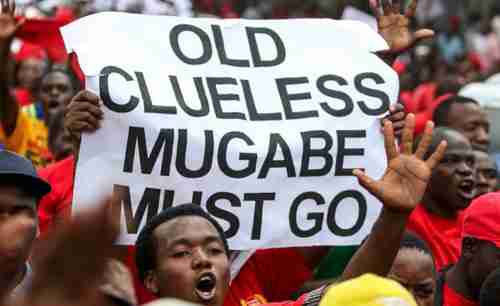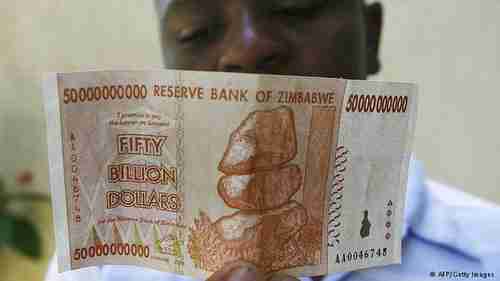This morning’s key headlines from GenerationalDynamics.com
- Zimbabwe police violently disperse protests over new ‘bond note’ currency
- Zimbabwe launching a Soviet style command agriculture program
Zimbabwe police violently disperse protests over new ‘bond note’ currency

Protestor holds up a sign saying ‘Old clueless Mugabe must go’ (The Herald)
As protesters on Wednesday in Harare, Zimbabwe’s capital city, started marching to the Reserve Bank of Zimbabwe to submit a petition over worsening cash shortages, heavily armed anti-riot police pounced on them, resulting in the protestors running in different directions. Some of the angry demonstrators pelted police officers with stones resulting police firing teargas and using water cannons to disperse them.
This is just the latest in widespread protests against Zimbabwe’s 92 year old president Robert Mugabe, whose decades-long reign has destroyed what was one of the strongest economies in Africa. ( “23-Jul-16 World View — Christian pastor’s ‘#ThisFlag’ movement threatens Robert Mugabe in Zimbabwe”)
As recently as the 1999, Zimbabwe was a breadbasket of Africa, exporting up to 500,000 tonnes (metric tons) of surplus food. By 2003, Zimbabwe was so starved that it had to receive 500,000 tonnes in food aid from the U.N.’s World Food Program.
What happened during those three years was a Marxist socialist “land reform” program by Robert Mugabe that confiscated 4,500 white-owned commercial farms and redistributed the property to his cronies from his own Shona tribe. Anyone from the hated Ndebele tribe who objected was jailed, tortured or killed.
Unfortunately, Mugabe’s cronies didn’t know anything about farming. Harvests of food staples plummeted by as much as 90%, livestock herds dwindled and production of the main cash crop, tobacco, slumped badly. The results were dramatic, and show how it’s possible for one dictatorial leader to destroy a country single-handedly. A formerly well-fed country had rampant 80% poverty, and the inflation rate went from 700% to 1000% to 10000% to 150000% and continued rising 500 billion percent.
In 2009, Zimbabwe switched to a dual-currency economy, accepting the US dollar as valid currency. At that point, the Zimbabwe dollar collapsed completely, and millions of citizens had their saving destroyed.
But instead of ending the destructive land reform policies, Mugabe added on a new one: Indigenization.
Indigenization required all Zimbabwe businesses to be majority owned by Zimbabweans, again mostly cronies from Mugabe’s Shona tribe. Zimbabwe continues to shut down businesses, including foreign banks, that do not comply with the indigenization requirements. Just as Mugabe’s “land reforms” destroyed the farm infrastructure, Mugabe’s indigenization law is destroying the entire business infrastructure.
But since Mugabe no longer has the power to print money, he’s run out of cash and is unable to pay salaries of public employees. To solve this problem, Mugabe is introducing a brand-new Zimbabwean currency, the “bond note.” The bond note is expected to be introduced in October, and one bond note is supposed to be the equivalent of one US dollar.
The Reserve Bank of Zimbabwe has claimed that the new bond notes will be perfectly safe because they’ll only be used for limited purposes, and no one will be forced to use them. Central Bank Governor Dr John Mangudya said:
“The intrinsic value of the export bonus or incentive scheme is to attract and enhance exports by Zimbabweans so that at the end of the day there is enough foreign currency in this country,” said Dr Mangudya.
“If you are getting a $400 salary, you will still get $400 in United States dollars, bond notes, rand or euros. If you don’t want them then you use plastic money. We are not forcing anybody to use bond notes.”
This triggered the protests and demonstrations because most people assume that Mugabe is lying. Some people are claiming that the bond notes will be as worthless as toilet paper.
In fact, Mangudya has already been forced to retract those claims, as he had to admit that public employees are going to be partially paid in bond notes. However, he added that the bond notes will still be perfectly valid, because they’ll be backed by a $200 million loan from the African Export-Import Bank.
But an opposition Movement for Democratic Change (MDC) official claimed last week that the $200 million loan will not last long, since the authorities are planning to print as much as $2.5 billion in bond notes, potentially triggering a new round of hyperinflation. The Herald (Harare) and VOA and News24Wire (Cape Town)
Zimbabwe launching a Soviet style command agriculture program

50 billion Zimbabwean dollar note from 2008 hyperinflation
Zimbabwe’s 92-year-old leader Robert Mugabe, who destroyed much of the country’s agricultural capacity with a “land reform” program that split up the farms and handed them to his cronies, is now launching a “command agriculture” program similar to the agricultural collectivization programs that failed so disastrously in Josef Stalin’s Soviet Union and Mao Zedong’s China, causing tens of millions of deaths.
The new “command agriculture” program will cost $500 million to start, to purchase seeds, fertilizer, tractors and irrigation systems. Each participating farmer will be given the seeds, fertilizer and equipment for free. The farmers will work under strict supervision of the government. Each farm will be required to produce five tonnes (metric tons) of maize for each hectare of farmland.
The farmer will be permitted to keep for himself all the maize he produces that exceeds five tonnes (metric tons) per hectare. There has been no announcement of what happens to the farmer if his yield is less than five tonnes per hectare, though we know that in the case of the Soviet and Chinese command agriculture programs, farmers who didn’t produce were starved to death or were executed.
Zimbabwe’s spring planting season begins in November (in the southern hemisphere), and so this program is supposed to begin at that time. At five tonnes per hectare, the government expects to produce two million tonnes of maize on 400,000 hectares of land, which would exceed the annual demand of 1.5 million tonnes.
According to Ryan Truscott, the Zimbabwe correspondent speaking on Radio France Internationale (my transcription):
Farming union officials say that that figure of five tonnes per hectare is far too ambitious. In a very few cases you can get five tonnes, or even as much as ten tonnes per hectare, but the average is just over half a tonne per hectare.
So there’s a very real possibility that the farmers won’t reach the five tonne targets, and won’t be left with anything for themselves. What happens in that scenario, for now we don’t know.
Another issue is the question of where the $500 million is coming from to fund this program. As we wrote in July, Zimbabwe currently owes $10 billion to the IMF, World Bank and the African Development Bank, with $1.86 billion in debt repayments in arrears, and is begging for more investment money. ( “1-Jul-16 World View — Zimbabwe, Venezuela, Puerto Rico – three amigos in Marxist economic destruction”)
The government says that’s all under control. Since the public banks are no longer available for borrowing more money, Zimbabwe will borrow from private banks, according to Zimbabwe’s vice president Emmerson Mnangagwa, who says that the money will be used to import farming equipment from Brazil, Belarus, Russia and India.
The private banks have not been named, but according to Mnangagwa:
The program is not being run on the budget (so) we are raising funds from the private sector and we are quite advanced at securing these funds. This is a cost recovery program, nothing is going to be given for free.
We cannot put a figure now. We are well advanced in negotiating such facilities and many private companies are coming forward to make offers because it is guaranteed that they will have a return from the loans that they may advance.
If, in fact, Zimbabwe is unable to borrow the money from private banks, then they may attempt to pay for the program with their new “bond notes,” and that will cause real problems. Zimbabwe Mail and The Herald (Harare) and The Zimbabwean
KEYS: Generational Dynamics, Zimbabwe, Robert Mugabe, Reserve Bank of Zimbabwe, Shona, Nbdele, John Mangudya, Movement for Democratic Change, MDC, Command agriculture, Soviet Union, Josef Stalin, Mao Zedong, China, Ryan Truscott, Emmerson Mnangagwa
Permanent web link to this article
Receive daily World View columns by e-mail

COMMENTS
Please let us know if you're having issues with commenting.